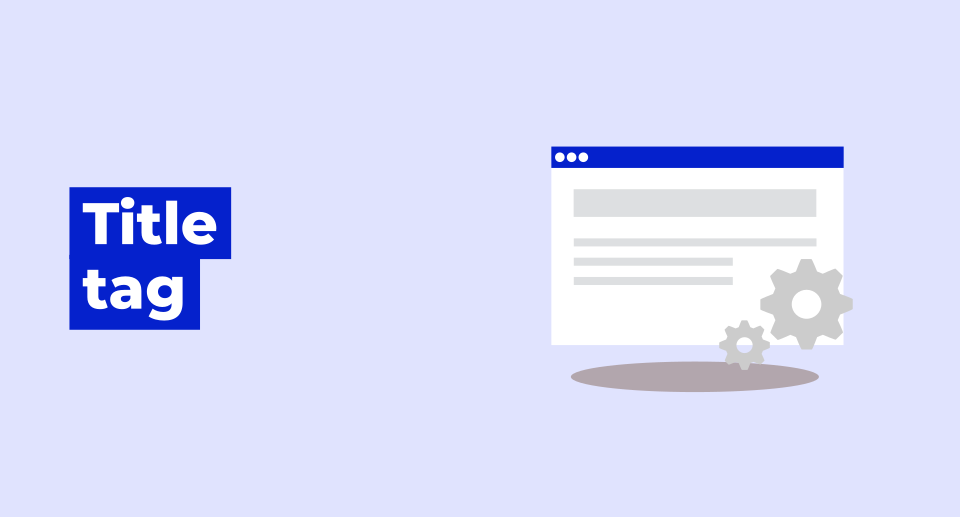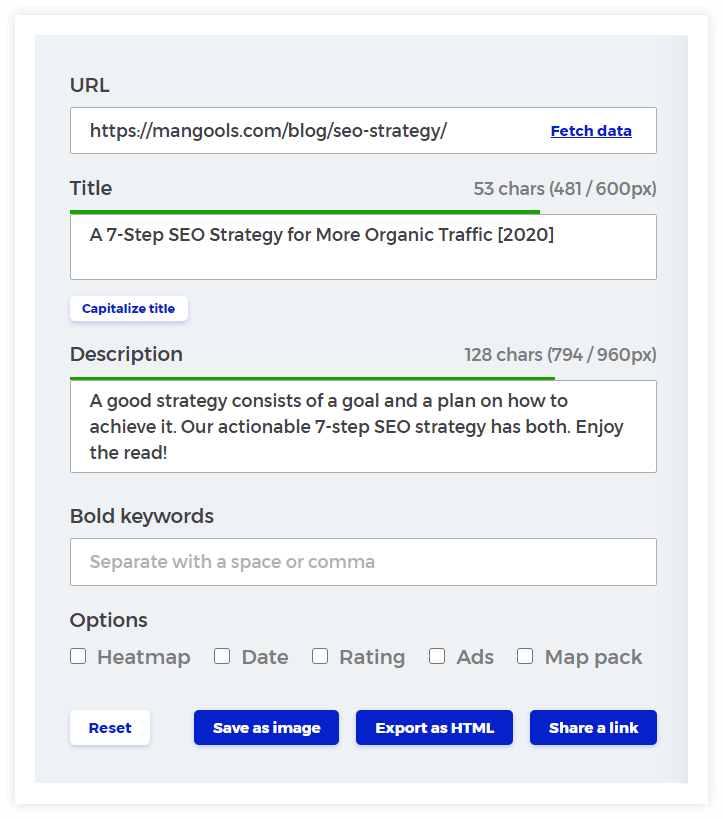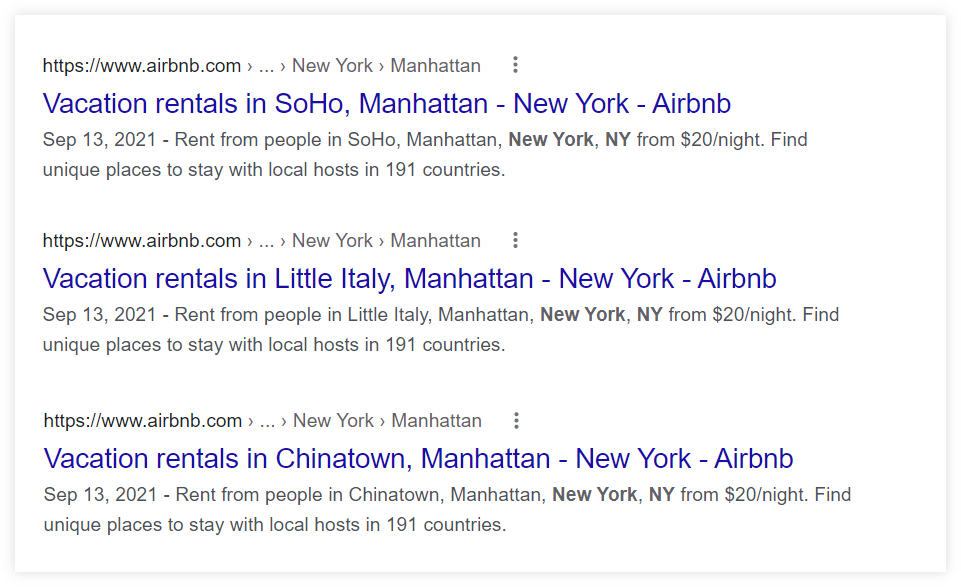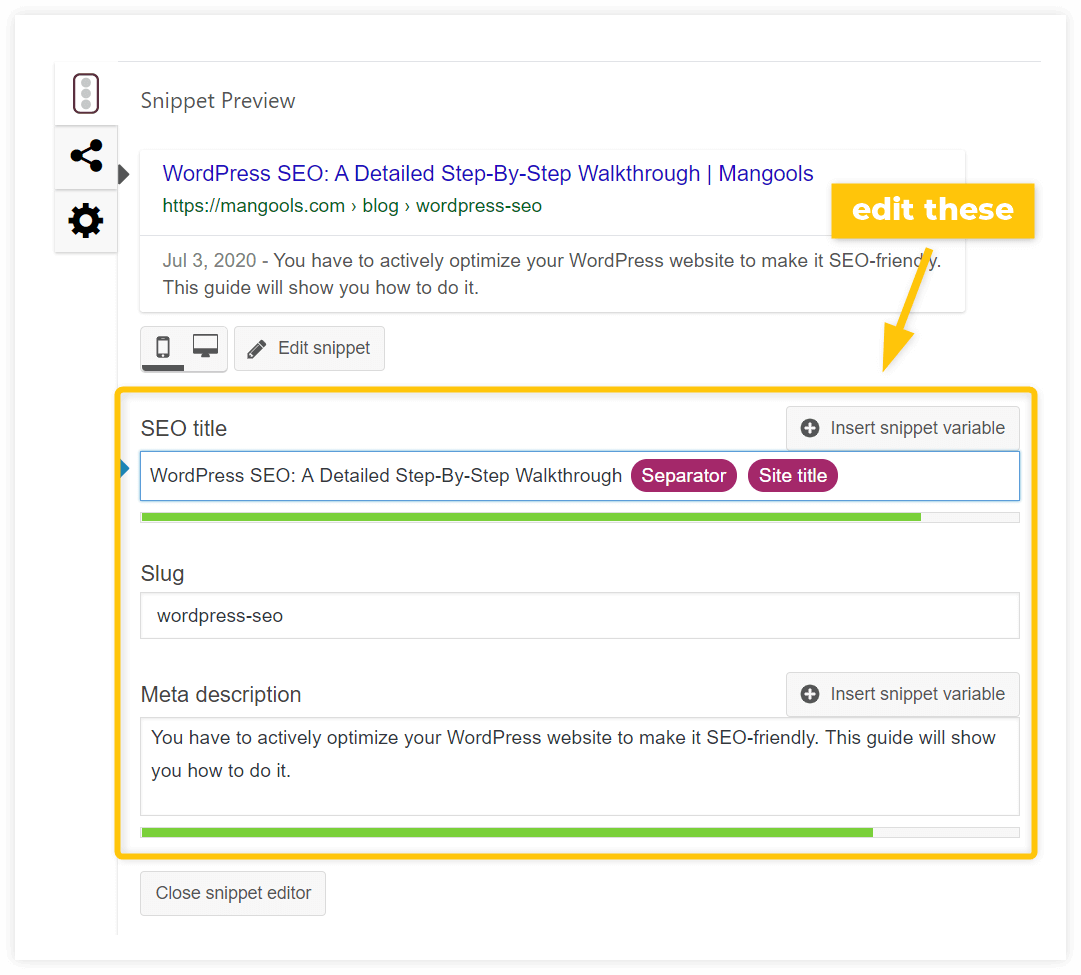What is a title tag?
Title tag (or page title) is a piece of code under the <head> section of the HTML document that represents the title of the webpage. It usually appears in the SERP as a blue, clickable headline that informs users and search engines about the content of the page.
Here’s an example of what a title tag looks like in the HTML code:
<head> <title>SEOpedia by Mangools | Ultimate SEO glossary</title> </head>
And here’s how it looks in the SERP:
What is the difference between the Title tag and H1 tag?
The title tag is displayed as a title in the SERP (and/or other places) but not on the actual webpage whereas H1-tag is the main headline that users can see when visiting the page.
Many website owners are commonly confusing these two HTML elements since they are usually identical or very similar.
Why is the title tag important?
Title tag has a significant impact on the website’s presence in the SERP. There are 3 important reasons why every page should have a well-written page title:
- It attracts users
- It serves as a ranking factor
- It improves visibility
Let’s take a closer look at the importance of the title tag from the SEO perspective.
1. It attracts users
The title tag can inform the users about the content of the webpage and convince them to click on the page.
The page title is like the first pitch that helps the users to quickly understand what the page is about and whether its content might be useful to them.
Therefore, a well-written title tag can improve the initial UX (user-experience) as well as boost the overall CTR (click-through rate) of the website.
2. It serves as a ranking factor
Google uses the title tag as one of the many signals that can influence the ranking of the page.
A properly optimized page title tells the search engine about the content of the page and can improve its position in the relevant search queries.
Be careful though with the optimization of the title just for the search engine.
In the past, many website owners tried to manipulate Google and improve their rankings by stuffing and spamming keywords into their page titles.
Nowadays, low-quality, misleading or spammy page titles can result in lower rankings or might not be used at all.
Even though the title tag provides some SEO benefits, it won’t automatically boost your rankings in the search results.
Don’t forget that Google uses over 200 ranking signals to provide high-quality results for the users – the page title is just one of them.
“We do use it for ranking, but it’s not the most critical part of a page.”
3. It improves visibility
Title tags are used not only in the SERP – they are displayed in other places as well!
Social networks such as Twitter or Facebook use title tags (and meta descriptions) in the preview of the shared link.
Other external websites might link to the page by using the title tag as the anchor text.
Note: Since social media might have different length limits for the title tags it is recommended to write copies that are designed specifically for them and use special metadata (e.g. OpenGraph) to implement them properly.
Besides the improved visibility on social media, title tags can help the users to better navigate between the pages by providing headlines in:
- Toolbars and tabs in browsers (e.g. Chrome or Firefox)
- Bookmarks and favorites
What is the optimal title tag length?
Although it is recommended to keep the length of the title between 50 – 60 characters, there is no universal formula on how long the title tag should be.
“The <i>title</i> length, that’s an externally made-up metrics … Technically, there’s a limit, like how long can it be anything in the page, but it’s not a small number. It’s not 160 characters or whatever– 100, 200, 20, or whatever.”
Even though there is not a precise character limit, Google will truncate page titles with the ellipsis (“…”) at the end if they are too long to be displayed on the devices.
Therefore it is recommended to measure title tags in pixels – as opposed to the number of characters – with a maximum length of 600 pixels.
Tip: You can test the length of your title tags in our free SERP Simulator tool and check out how your titles would look like on the actual result pages together with other elements of the snippet such as page URL or meta description.
Always make sure to try various page titles before publishing your final version.
How to write a title tag?
Although writing page titles is no rocket science, it requires a little bit of practice, SEO skills and marketing thinking.
Here are few actionable steps for creating high-quality, relevant and well-optimized title tags:
- Be concise and descriptive
- Optimize for search engines
- Provide unique titles
- Write compelling titles
- Check your competitors
Let’s take a closer look at best practices and examples that you should keep in mind during the writing process.
1. Be concise and descriptive
The title tag should describe the main idea of the page just in a few words.
Users should be immediately able to understand what the content of the page might be about just by looking at your title.
Try to avoid too general and vague words such as “homepage” or “product category” since these terms are not very descriptive and do not provide any value to the users.
Keep in mind that the title tags have their space limit after which they get truncated by Google – always make sure that your title is not longer than 50 – 60 characters (or ~ 600 pixels).
Here is an example of what a concise yet descriptive title tag looks like:
2. Optimize for search engines
Try to naturally include your focus keyword into the title tag to reflect the topic of the page.
Including keywords into the copy of the title can help search engines (and users) to better understand the content of the page and improve your rankings in search results.
Be careful though not to over-optimize your title as it can look spammy for Google and discourage users from visiting the page.
Avoid keyword stuffing or keyword cannibalization as it won’t provide any benefits other than hurting your website’s rankings and worsen the UX.
3. Provide unique titles
Make sure that all your page titles are unique and provide value for the users.
Identical (or very similar) page titles would create duplicates – therefore they will be ignored by Google and won’t be displayed in the search results at all.
Tip: You can use tools such as Screaming Frog SEO Spider or Sitebulb to check whether your website contains pages with duplicate title tags.
For some sites, however, it might be difficult to write a proper page title for each product page and category – especially if there are thousands of them (e.g. e-commerce websites).
In this case, there are a few options that can help you resolve the issue with duplicate title tags within your site:
- Focus on main pages – if writing unique title tags for every page would take too much time and resources, try to prioritize the most important pages that bring the most organic traffic to your website. Simply create a list of all your URLs within the site and prioritize them according to your needs (e.g. earned revenue, organic traffic, etc.) and provide unique titles to the most important ones.
- Generate titles automatically – website platforms and plugins (e.g. Yoast SEO) can help you generate title tags across your whole website by managing page titles with set-up variables together with custom keywords, product names and other parameters. Thanks to these programmed templates, it is much easier to create relatively unique titles without manually writing them for every page.
Here’s an example of automatically-generated title tags on the Airbnb website:
4. Write compelling titles
Create an attractive and meaningful page title that would immediately catch the reader’s attention.
Providing a copy that would stand out from the others in the SERP and bring users to the website is the most crucial and the most difficult task in the process of writing.
Luckily, there are a few actionable steps that could significantly improve your title tags and make them more compelling for the users:
a) Put your keywords first
Keywords that are closer to the beginning of your page title may catch the reader’s attention much more quickly.
Users usually check just 1 – 2 words on each title in the SERP before they move on.
By including your focus keyword first, the title might seem more relevant and attractive for the users since it matches their search query.
Check this example with the keyword “coffee beans” at the beginning:
b) Include brand name
A well-known or trustworthy brand in the title can improve the CTR (click-through rate) of your page significantly.
As a rule of thumb, it is recommended to write the name of your brand at the end of the title tag since otherwise, it would take up precious space for more important information at the beginning or in the middle.
You can include your brand on almost any page title (with a few exceptions such as your homepage).
Here’s an example of how a brand can be included in the title tag:
Keep in mind that even if you decide not to include the brand in your title tags, Google may still automatically display page titles with the name of your brand for certain search queries.
c) Use power-words, numbers or dates
Strong words or expressions such as “ultimate”, “everything” or even “best” can persuade the reader to click on the title and improve the CTR of the page.
You can also combine numbers with phrases like “7 actionable steps” or “… all in 10 minutes” to make them more appealing to the users.
With the topics that are time-sensitive and need often updates and changes, you can include the date too. Like in the example below:
Tip: You can also include years or limited time periods (e.g. “best smartphones 2021” or “10% discount today”) for time-sensitive topics such as news or monthly trends to evoke urgency in the visitors.
d) Include special symbols and all-caps
Special characters such as brackets “( )”, dashes “-“ or even pipes “|“ can differentiate your title tag from the rest and improve its readability in the SERP.
You can also improve the format of your title by using capital letters for some words or phrases – just don’t overdo it since it may start to look a little bit spammy and take up too much space on the result page.
Note: Be careful when implementing special symbols in your copies as they might not be properly displayed in the result pages or may create mistakes and errors within the HTML code of your page. Read more about this topic in this practical guide by Search Engine Journal.
5. Check your competitors
Try to get some inspiration from the competitive pages and see what titles appear in the top results.
You can either manually go to the HTML code of every competitive webpage that is ranking in the SERP or do it easier by using tools and plugins such as Mangools SEO extension and obtain valuable on-page SEO data such as:
- Actual copy of the title
- Number of characters in the title tag
- Preview of the title on social media
- Provided meta description
- Overall snippet preview in SERP
How to add a title tag?
Title tags can be added to your pages either manually or through your CMS (e.g. WordPress).
If your site is not hosted on any CMS, you need to access the HTML document of the page and insert the title tag to the <head> section of the page.
If your site runs on WordPress, you can select from plenty of SEO plugins (e.g. Yoast SEO).
Adding title tags this way is a much easier and pretty straightforward process:
- Open a new or an existing post in your WordPress editor
- Scroll down to the bottom of the editing page
- In the Yoast SEO section, click on the “Edit Snippet” button and add your copy to the SEO title tab.
- Hit the “Update” button
Info: If you would like to know how to add title tags in other popular CMS platforms as well, check out these guides for:
Can Google rewrite my title tag?
Yes, Google can generate its own page title in the SERP and use it instead of the original title tag.
It is pretty common for Google to slightly tweak or completely change the titles of the pages:
“In fact, Google almost always rewrites titles. We couldn’t provide useful results to our users if we quit rewriting titles. Experiments showed us users preferred written titles. So, we’ll continue to write titles.” (Gary Illyes, Webmaster Trends Analyst at Google)
The rewritten title does not necessarily mean that the provided title tag is bad – but there are a few instances that can cause a change in your title’s appearance:
- No title tag is present – in this case, Google will simply try to generate its own title from the content of the page or other sources.
- Low-quality title tag – spammy, inaccurate, or misleading page titles are often ignored by the search engine and will be rewritten to provide better results.
- Duplicate title tag – pages with identical titles wouldn’t look very good in the SERP. In this case, Google will try to extract unique information from the pages and generate its own, more original page titles.
- Headline as a title – Google might even use the H1 tag and other headers from the page if they would serve as a better title for search results (this also includes other prominent content on the page or anchor texts that point to it).
- Missing brand name – search engine often prefers brand name to be visible in the displayed title tag. Therefore it might rewrite or shorten the title in order to fit the brand name at the end of it.
- Disallowed crawling – in rare instances, a website might be blocking crawlers from visiting its pages (e.g. by robots.txt) but they might still end up in the Google index. In this case, pages could be shown in the search results but with different page titles – since Google was not allowed to check and crawl their title tags.
- Matching the search query – even with well-optimized and appealing title tags, Google will create its own versions to better match various search queries.
Or as Google officially stated:
“…sometimes even pages with well-formulated, concise, descriptive titles will end up with different titles in our search results to better indicate their relevance to the query.”
















